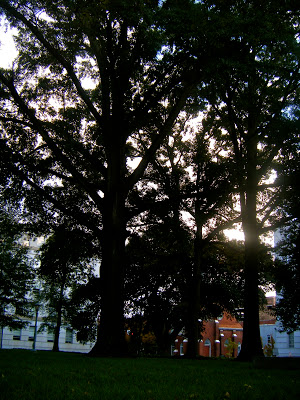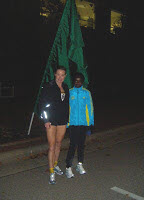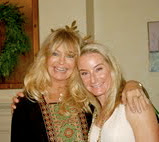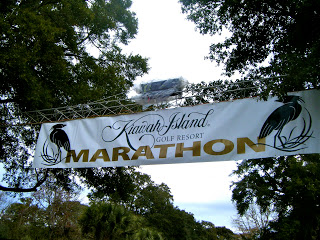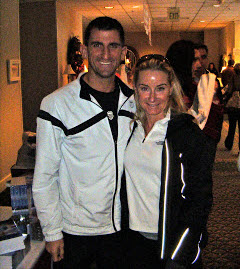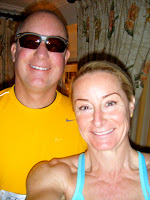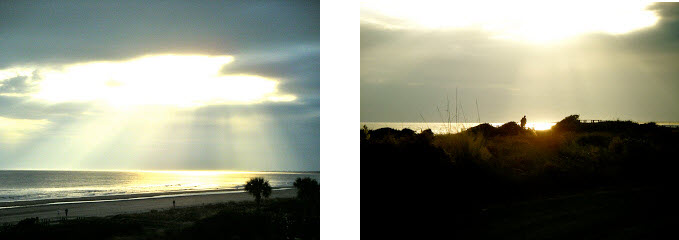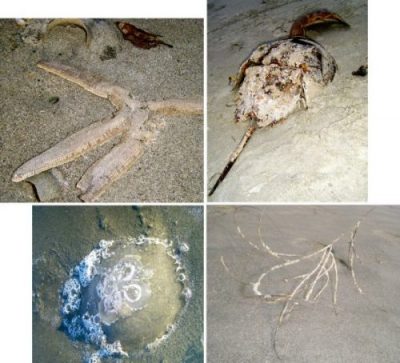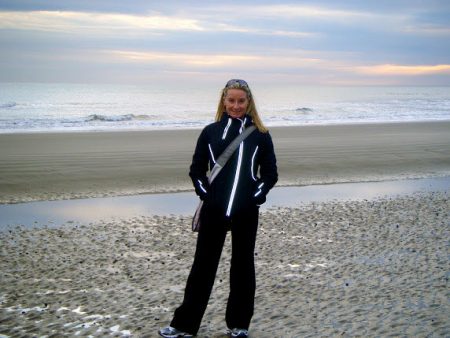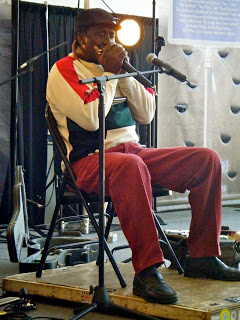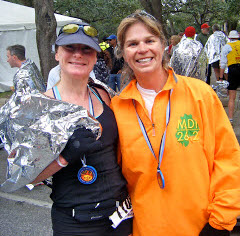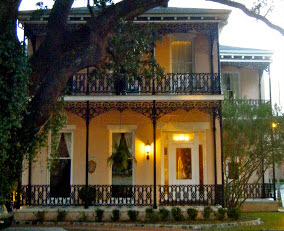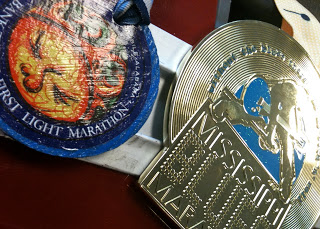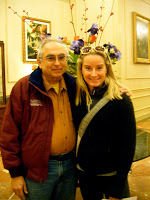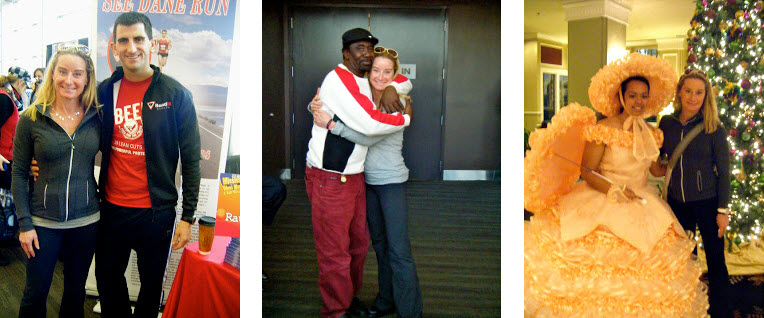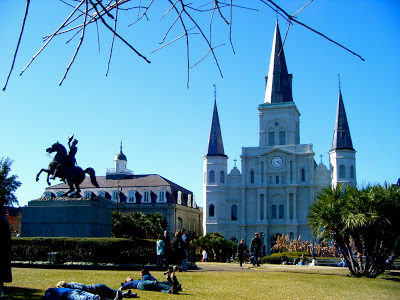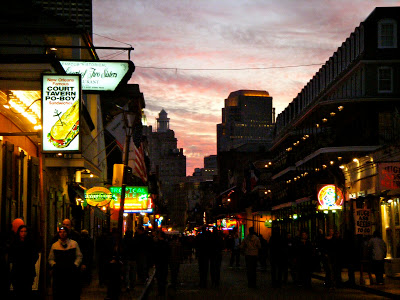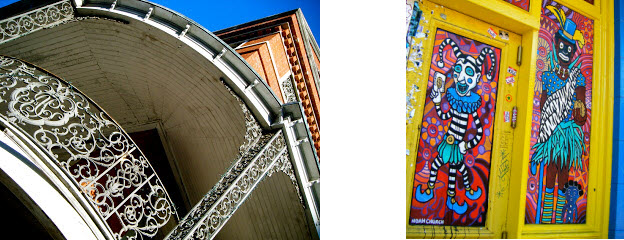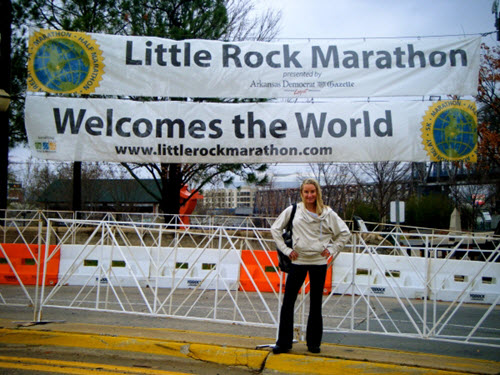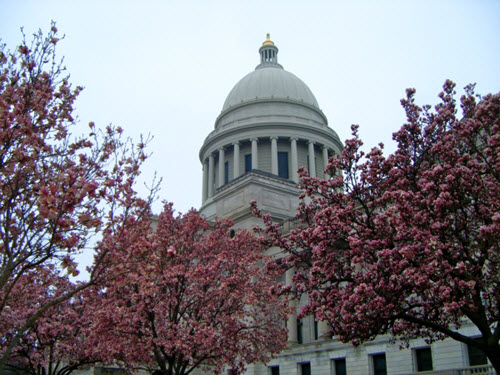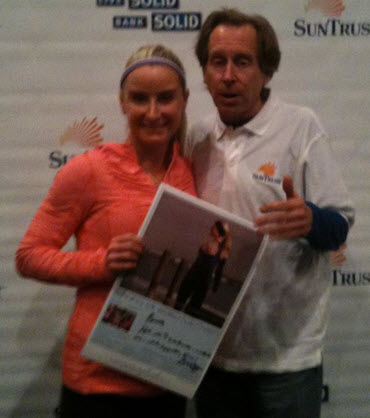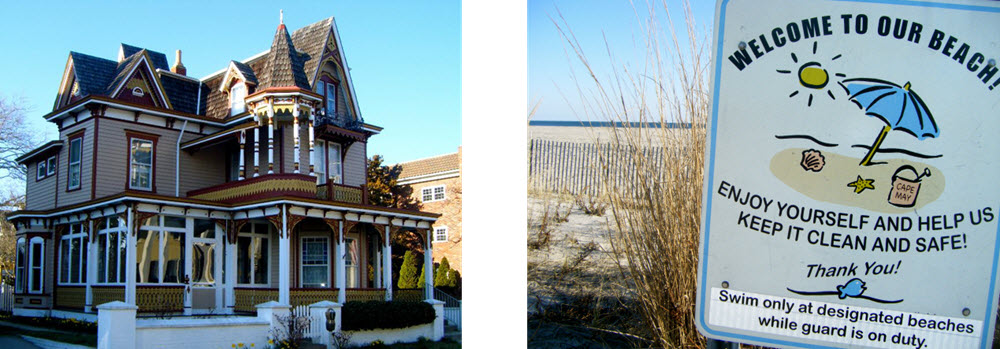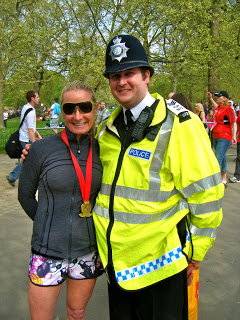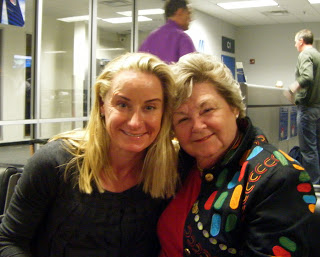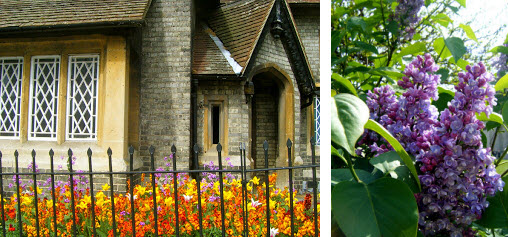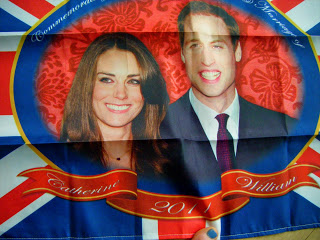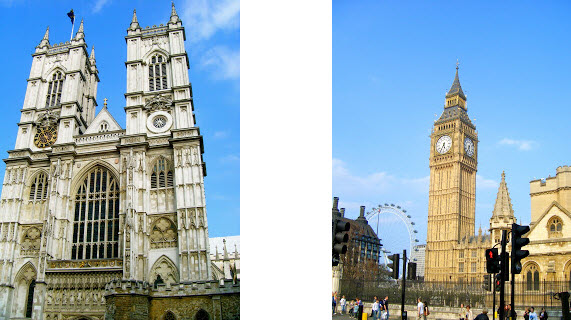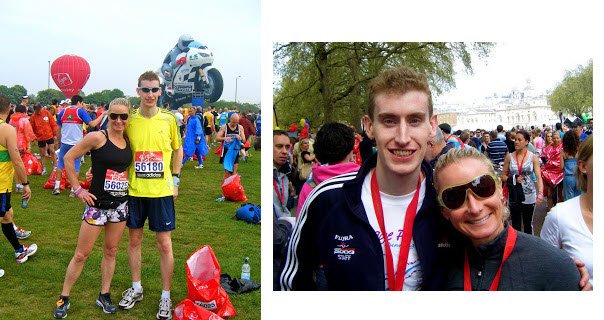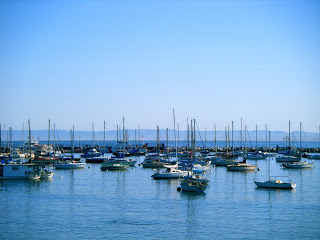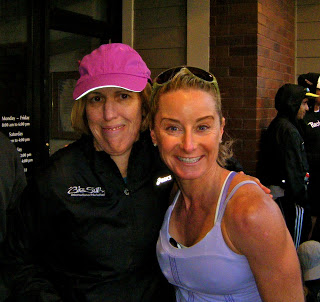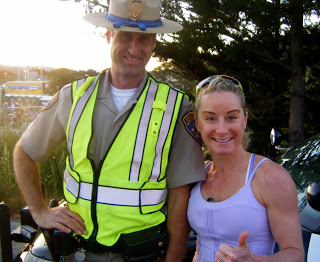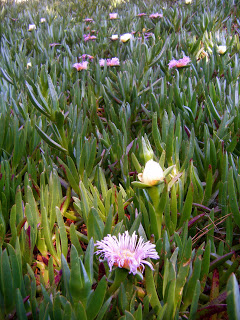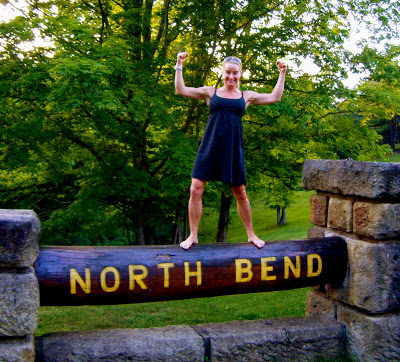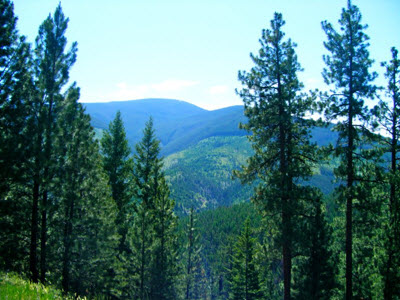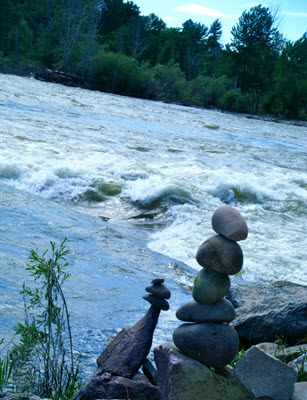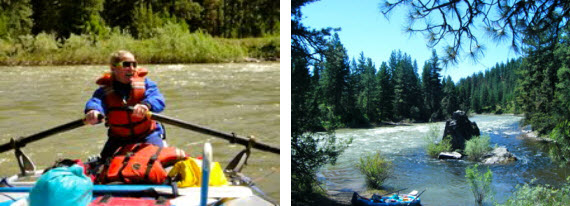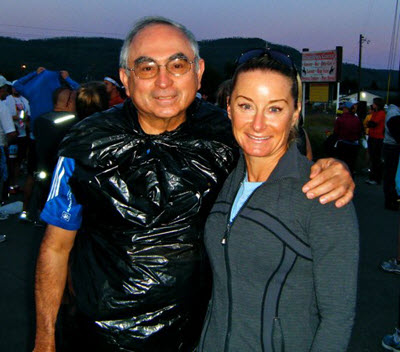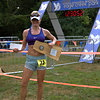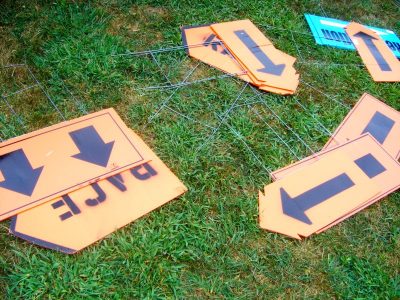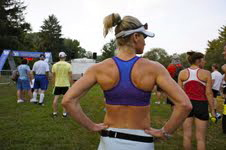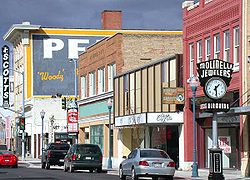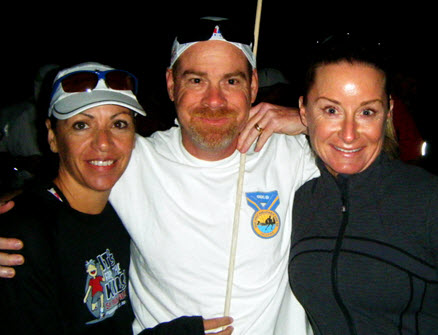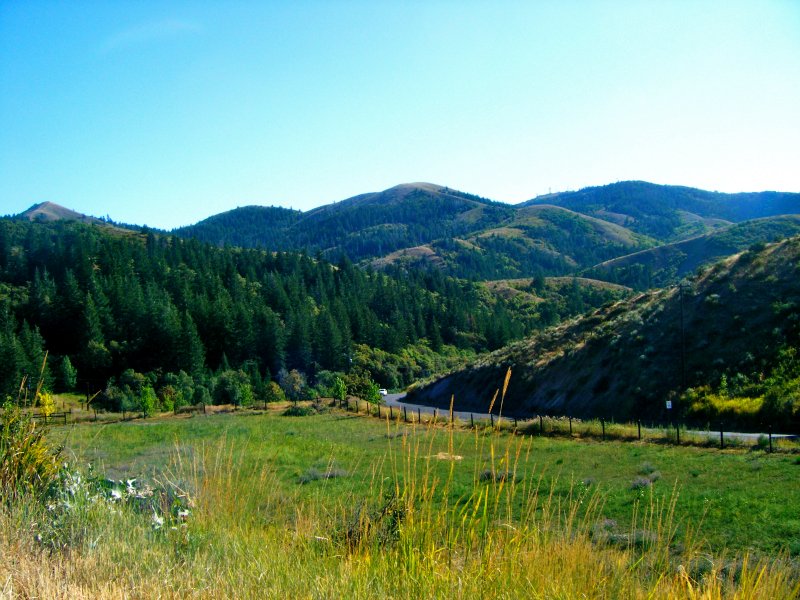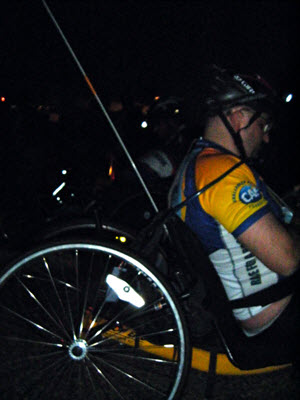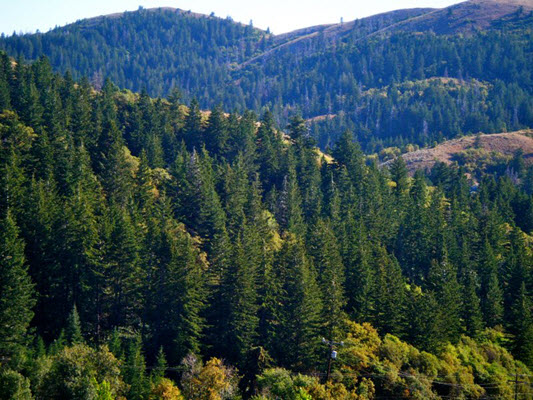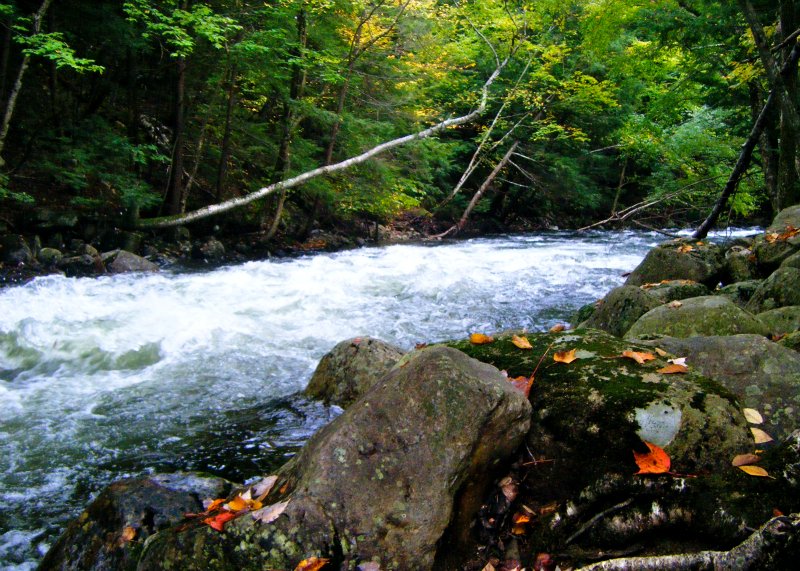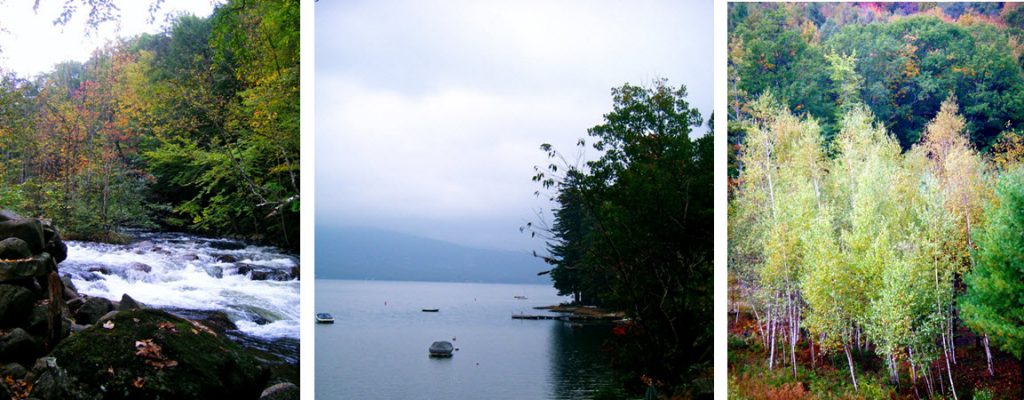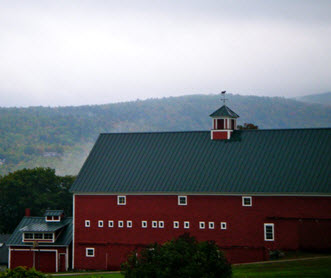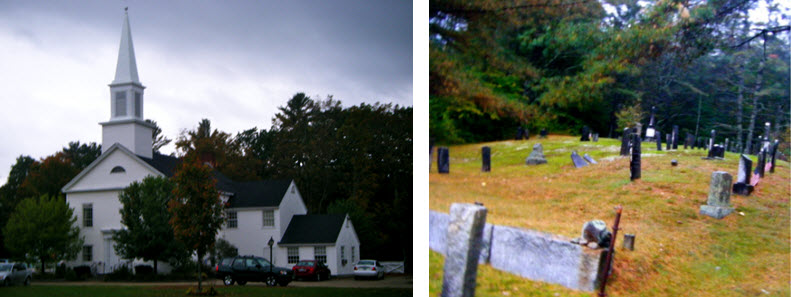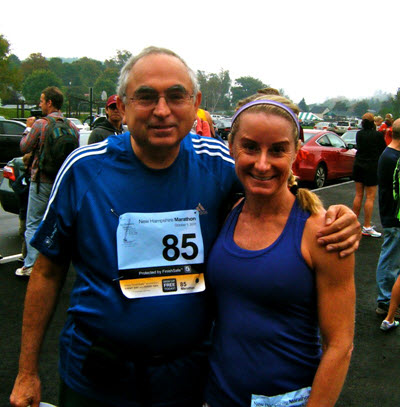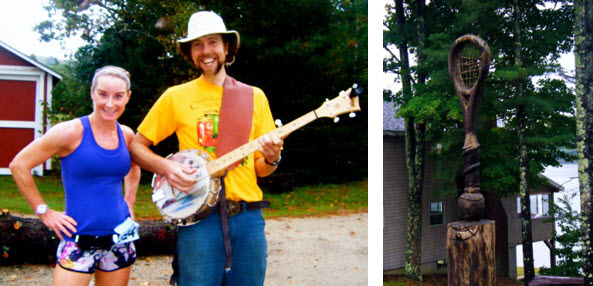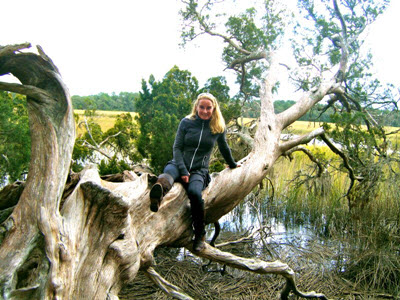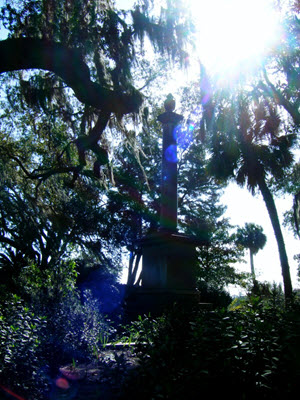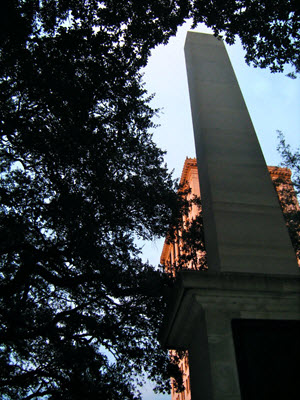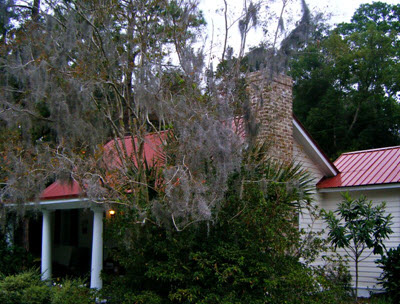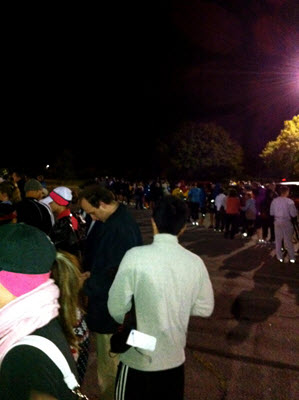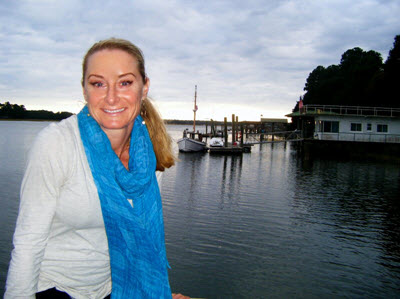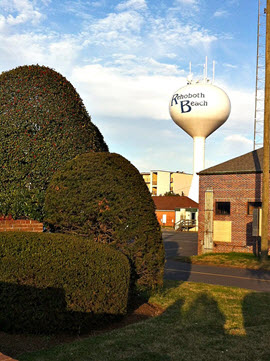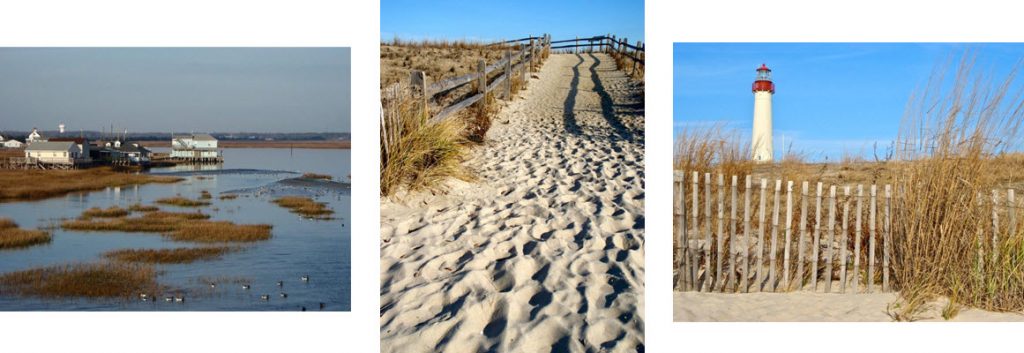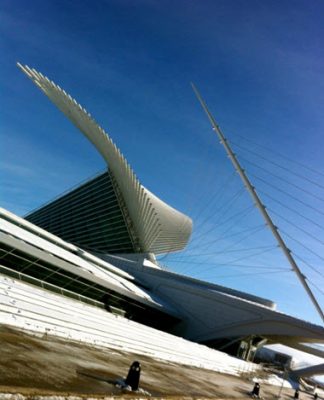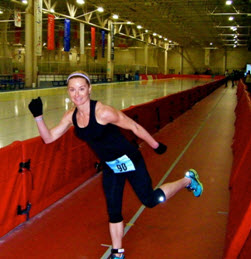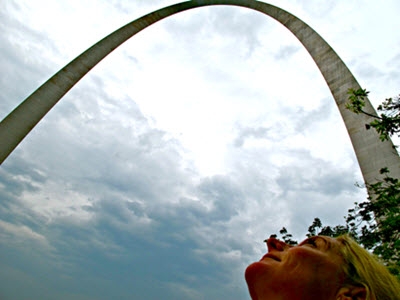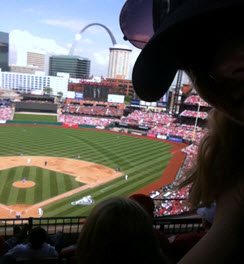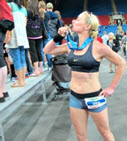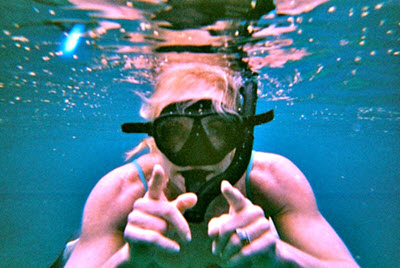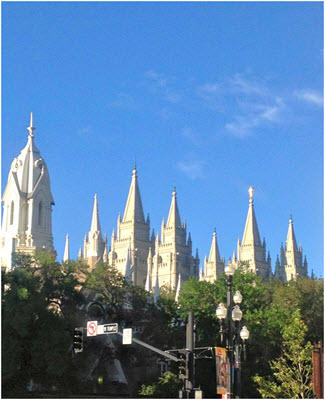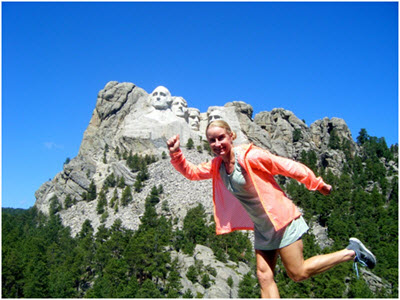Brooke’s Marathon Stories 26-50
26 – City of Oaks Marathon 11/07/2010 Raleigh, NC
Finally a marathon that I could drive! Favorite Daughter #3 and I pulled out of Alexandria just before the Friday rush-hour(s) traffic and headed for Raleigh. Soccer tournament (CASL) for her, marathon for me — state # 17, marathon # 26 and marathon # 11 in 2010 — and Favorite Father’s 75th birthday…
Founded in 1792, Raleigh is North Carolina’s capital city. Named after Sir Walter Raleigh — who attempted to establish the first English colony in the New World in the 1580’s — it was soon known by its citizens as the City of Oaks. And they dedicated themselves to the oaks preservation…
* Thanks Raleigh Observer for the great RunningBrooke press. They consider me part of the hard-core contingent who love to run marathons — i.e. me and The 50 States club.
* And to FYI Alexandria (city’s e-letter) for the feature…
So, without further ado…
The Good
The Marathon. The course started and finished at N.C. State University and featured a surprisingly scenic and diverse way through downtown Raleigh, the city center and the beautiful Umstead Park. Felt great and finished in a respectable time — fastest this year. Plus, I was able to stay WARM until race start. Sweet!
I met and jogged with 1/2 Marathon Winner Maria Busienei, origionally from Kenya. She led the women with an average of a 6:08/mile and a 1:20:21 finish.
The Soccer and The Birthday…
The Downtown Walk-A-Bout…
Completed in 1840, the capital building is a great example of Greek Revival architecture. Total cost: $532,682.34, three times more than the state’s general income at the time…
The Perfect Equipment…
Kudos to Gracie, who had a booth at the marathon expo, at gracies gear for the design and development of (possibly?) the most perfect, chafe-free, non-belt carry-option out there. For demo, it holds phone and chap-stick but race day, it held 5 GU’s, car key and inhaler…
Am a little envious — written with a smile — as many runs ago, I was in the planning phases of co-marketing the similar idea of running-pal Kathy. Ours was going to be called the Gu Garter. Shrug. Missed opportunity…
The Bad (no Ugly, sorry)
The car. Great option pre-race, but an albatross, post. Loads of time wasted trying to circumvent on-going marathon and stress of the GPS Genie calling out invalid directions. Thanks to the nice Raleigh policemen who after listening to my plight, allowed me to cross the marathon path…
27 – Kiawah Island Marathon 12/11/2010 Kiawah Island, SC
Thirteen marathons run in 2010, one-a-month, with two in May! To recap, this year I’ve raced in Florida (Goofy Challenge — half, then full marathon), Arizona, Nevada, Oklahoma, Oregon, China, Minnesota, Australia, Alaska, Nebraska, Connecticut, North Carolina and South Carolina. I’ve racked up over 95,000 flight-miles and together, we’ve raised over $26,500.00 for Alexandria’s kids and families!
2011 takes me to Mississippi, Texas, Louisiana, New Mexico, London (5th and final major – a category closer!), West Virginia, California, Wyoming, South Dakota, Utah, New Hampshire, Indiana, and either Alabama or Hawaii…
I’d like to say ‘thank you’ and send hugs to all of my supporters. Your support of me is giving support to Alexandrians in need. It’s giving a family a safe place to call home. It’s providing preschool classrooms for a jump start in life. It’s providing books to homeless children and after-school tutors for homework and extra help. Your donations are putting food on tables and giving stability to where none was.
I’d like to bring special attention to my Sponsors: Bonitt Builders, Pacers Events, a division of Pacers Running Stores, McLaughlin/Ryder Investments, TJ Fannon & Sons, MacNair Travel Management, Mark G. Anderson Consultants, Sean McEnearney and McEnearney Associates and McGinn Investment Management, INC. These are local businesses who have laced up their shoes to donate $1K a year over the next 5 years to The RunningBrooke Fund. And neighbors, as your checks keep pouring in, I am inspired by your giving, and my heart warms with the encouraging notes.
*A final note before the Kawah Island marathon report…
Earlier in the month, we had a terrific time hosting an event at the house for Goldie Hawn. Visit The Hawn Foundation to learn more about her work with children!
So, without further ado:
Kiawah Island, in South Carolina’s low country was calm and beautiful. Spanish moss hung low from most every limb, and even though it was cold and windy (and rainy), you could imagine a hot and sultry afternoon, dappled sunlight filtering through the dense canopy.
*Factoid. England ‘purchased’ Kiawah Island from the Kiawah Indians on March 10, 1675. Purchase price: cloth, hatchets, beads plus other manufactured goods…
I’ve known of Dane, and followed his blog for years, and it was good to finally meet him. Dane lost a bet. The result? Him running 52 marathons in 52 weekends. Love it! To learn more, check out his website: See Dane Run.
Favorite husband was with me — he celebrated a big-number birthday, but you’d never know it…
Can’t say that he was thrilled about the half-marathon distance — he’d probably have preferred a 10K — but he finished well. I had a lot of fun being and running the first 8 miles with him! Half-marathon today, marathon tomorrow, because if you can run a half — with little training — you can run a full — with some training — for sure!
This was a terrific weekend. The marathon was a beautiful loop, run twice. There was no Bad and certainly, no Ugly. So I’ve had to deviate from my normal Good/Bad/Ugly format… Sorry fans. As you’ll see from my pictures below, I was fascinated by the interaction of light and color, by the reflections in a winter-beach landscape, by the birds foraging for food and by all things washed up on the shore.
I wish you all Happy Holidays and Peace in the New Year.
28 – Mississippi Blues 01/08/2011 Jackson, MS
29 – First Light Marathon 01/09/2011 Mobile, AL
Successfully made it through my first double-marathon weekend! Two marathons, two states, two days. I’m grateful that it all worked out. It seemed like a fairly reasonable idea since I’d already run a 50 miler (JFK50, 11/09), and I thought that if my body could handle that, it could handle two marathons in two days. Only 2.4 additional miles, right? It was a mental game of perseverance — a ‘just do it’ attitude — and putting one foot in front of the other. Not over-thinking, just starting… The hardest and most stressful part of the weekend though, was navigating back through the Atlanta airport before the big storm hit on Sunday. Made it home by hustling, riding standby (3 times), and a whole bunch of luck.
So without further ado…
Part 1: Jackson, MS and the 4th annual Mississippi Blues Marathon 1/8/11.
A small marathon — 665 finishers — with a big marathon feel. A very friendly place where onlookers yelled “thanks for running in Jackson!” My goal was to take it easy and finish strongly, with enough left in the legs to run again on Sunday. Fairly pleased to finish 146th overall, 8th in my division with a 3:46. Especially with the relentless hills… Big thanks to Ken from Celebration, FL for providing the tunes — ipod/speaker attached to his belt. He and I ran from mile 6 on, and played ‘name the song/artist/band/album…’ Highly entertaining. See you in New Orleans, Ken!
Jackson, located on the Pearl River, is the State Capital and the largest city in Mississippi, with the slogan: City with Soul. And it has that. In and around Jackson are known for its greats: Elvis Presley (race day was his birthday), Muddy Waters, Charley Patton, BB King, Bo Diddley, just to name a few. This unique Mississippi art form has long been recognized as the foundation for much of today’s music. It’s tangible, a way of life.
Since the mid-60’s, Jackson has undergone a series of dramatic changes and growth. Much of its downtown has been replaced by modern-ish buildings that little resemble a city with history.
Named after President and General Andrew Jackson, in recognition for his victory in the Battle of New Orleans, Jackson in the 1960’s became a site for civil rights activism. A place of sit-ins, merchant boycotts, Freedom Rides and the murder of Medgar Evers. Evers was a prominent civil rights activist and leader of the Mississippi chapter of the NAACP. Thousands marched in his funeral procession to protest the killing.
Part Two: Mississippi to Mobile, Alabama, and the 10th annual First Light Marathon 1/9/11
After some finish-line red beans and rice (with Andouille sausage) — I know this will surprise some of you — I drove 200 miles from Jackson, MS to Mobile, AL, in my hot-rod, rental car.
Fun to drive, and pleased that I didn’t get lost OR get a ticket (8 hours of recent driving school left an impression).
Mobile (pronounced / mou’bi:l / moe-BEEL) Finally got the pronunciation right just as I was leaving. I kept wanting to say Mobil, as in Mobil oil.
Mobile is the third most populous city in Alabama, and sits at the junction of the Mobile River, Mobile Bay and the northern Gulf of Mexico. That’s a lot of water! But it is the state’s only seaport. Mobile felt like a less-amplified New Orleans, more Old Town less Georgetown.
*Factoid: Mobile is known for having the oldest organized Carnival celebrations in the United States, dating to the 18th century and its early colonial period.
And I’d go back there in a heartbeat. For everything Jackson has lost in its old-style architecture and sense of “walking back through time”, Mobile has retained. Huge trees, converging limbs, and large concentration of historic architecture.
Sunday’s course was much flatter (thankfully) and was run to support the L’Arche Mobile organization, an international group that helps those with intellectual disabilities lead fulfilling and independent lives. Unbelievably, I felt pretty good — the hardest part, motivating to the start line. Finished 3rd in my age group with a 3:55, 95th out of 471 finishers. Thanks to Paula — Lobsterman from Maine — for her entertaining stories and descriptions about her life as a lobster-boat captain. Made for a very quick 20 miles.
*Factoid: This marathon was not chip-timed. We ran into chutes and tore off the bottom portion of our bib to record our finish place.
Like Jackson, Mobile struggled with social justice and race relations. By 1840, it was the second only to New Orleans in cotton exports for the nation. As we all know, Mobile was part of a Confederate state and we know the history. Starting at the turn of the 20th century, segregation ordinances and Jim Crow laws were passed, legislating what had been the informal segregation practices. After WW II, according to some accounts, Mobile became more tolerant and racially accommodating — compared to other cities in the South. Its police force and Spring Hill College were integrated in the 1950’s and bus and lunch counters were voluntarily desegregated by the early 1960’s.
The Good
Running two marathons (#28 and #29), in two states in two days. And, it wasn’t that hard.
Reuniting with running-pal Jerry. Jerry has completed marathons in all of the continents and is on his way to finishing the states. Way ahead of me! Jerry and I compare marathon notes, okay, it’s usually him giving me loads of practical advice and me following his instruction to the letter. He and I have run simultaneous marathons in Easter Island, The Outback, Omaha, Hartford and now Jackson.
Hearing awesome Blues at The Mississippi Blues marathon expo and getting a good sense of what Blues is all about.
The Bad/The Ugly
The Atlanta Airport. Just the thought of being stuck there.
30 – New Orleans Mardi Gras Marathon 02/13/2011 New Orleans, LA
Just back from New Orleans and the Mardi Gras Marathon. Being Bawdy, Tawdry, and historic, it made, to say the least, for an interesting visit. Favorite Daughter #1 and I had a great time and we both got our eyes full, and saw some unexpected things on Bourbon Street! “And that’s all I got to say about that.” Forrest Gump…
New Orleans, founded in 1718, was initially a small trading camp on a curve of the Mississippi River. Later, the city was organized into a rectangular community known as the French Quarter. As the city grew, it followed the curve in the river and because of its shape, became known as the Crescent City. Because New Orleans was surrounded by swamps and marshes — sea level (some places below sea level) to approximately 6 feet, and because of the annual flooding of the Mississippi River and water surges from hurricanes, levees and canals were built to block and drain the excess water. Interesting to learn however, that long-term and ongoing destruction of surrounding wetlands and the building of levees and canals meant to remedy the problem, actually exacerbated the flooding and elevated the potential destructive effect.
*Factoid #1: New Orleans has more miles of canals (above and below ground) than Venice, Italy.
*Katrina exhibit at the Louisiana State Museum
*Factoid #2: New Orleans has over 35,000 structures on the National Register of Historic Places. That’s 15,000 more than Washington, DC.
And now, without further ado:
The Good
The Marathon. I got to run the first 6 miles with Favorite Daughter #1 before the 1/2 and full marathon courses split. Thumbs up to the race director for weaving us through historic and beautiful sections of the city.
Remember ‘music belt’ Ken from Jackson, MS? He and I met up at at mile 8 and ‘rocked on’ playing ‘name the artist/song/year/album.’ See you in Little Rock!
Bourbon Street and the carnival-like craziness and the raucous and sometimes-ridiculous behavior of those on it.
The Food and The Music. We ate are way through the French Quarter — jazz and blues music pouring out onto the sidewalks — with Crawfish and Crab Etouffee, Red Beans and Rice and Jambalaya. Finished it all off with warm Pralines.
*Factoid #3: 40% of all the seafood consumed in the US comes from Louisiana
The Bad
The Marathon. I ran with a painfully annoyingly side cramp for 25 miles. AND I cavalierly ignored one of the main tenets of long-distance running. Never, ever, under any circumstance, use/wear something new and not broken in.
Things left undone
We walked (and walked) the city but missed some local highlights due to time constraints: Riverboat tour on the steamboat Natchez, Katrina Tour to see areas devastated by the hurricane, Road to Freedom and Plantation Tour and Airboat Adventure through swamps. Next time.
and The Unexplained
The Voodoo thing… just don’t get it
That’s it. The Louisiana chapter is closed! Next up, Little Rock, AR. on March 6. A race I registered for solely for the finishers medal. It’s the size of a platter; shallow of me, I know… Cheers and Run Strong (literally or figuratively).
31 – Little Rock Marathon 03/06/2011 Little Rock, AR
On March 6th I ran the Little Rock, Arkansas marathon and crossed off State #22 and Marathon #31 on my quest to run a marathon in every state and on every continent in order to bring attention to and raise money for 5 vital Alexandria-based charities serving the at-risk in our community. Spring had begun in Little Rock; the Redbuds had begun to bloom and the daffodils were up.
Arkansas, Native American for “south wind,” and nicknamed The Natural State, has over 600,000 acres of lakes, 9,700 miles of streams and rivers and over 2.6 million acres of national forests.
*Factoid. Our nation’s oldest national park (Hot Springs) is in Arkansas.
It is a place with stories; tales of Native Americans, Pioneers, Civil War battles, oil and diamonds, Blues and Mountain music. The home state of former President Bill Clinton but also the land of historic Civil Rights struggles:
1. The Trail of Tears — forced relocation of south-eastern Native Americans made to walk from their homeland westward (across the entire state of Arkansas) on their way to “Indian Territory” in Oklahoma.
2. The Internment Camps — involuntary relocation of Japanese-Americans from across the US during WWII. Two sites, now memorials, are in Arkansas.
3. The Little Rock Nine — escorted by the military, nine African-Americans enroll at Little Rock Central High School in 1957.
And so without further ado:
The Good
The Marathon. 1,814 marathoners (plus 1/2 marathons and 1st-leg re-layers) lined up for the 8AM race start. It was a perfect day. Overcast with a starting temperature in the mid-thirties. ‘Music Belt’ Ken (remember him from Jackson and New Orleans?) and I stayed warm in the Peabody lobby (yup, mallards in that fountain too) until 7:45; walked to the race start, corralled up and went. The course took us past the Clinton Library, through the city and by the capital, before leading us out into the suburbs. This is where the race got even better. We ran past Little Rock Central High School (combo of Art Deco and Gothic and massive in size), past the Governor’s Mansion (Governor and staff out front waving to us!) and finished the last 6 miles along the Arkansas River. Double-thumbs-up to the Race Director for a great tour!
The Marathon. This isn’t a typo. I felt so obnoxiously good during the race that I probably bothered other runners. Came in 8 minutes faster than New Orleans (easier course) and BQ’d (Boston Qualified) under the new, faster time limits. What did I do differently between these two races that I hadn’t done before? I worked on my flexibility. Check out this video (painfully unedited, sorry).
The Marathon’s Finisher’s Medal. It’s the reason I decided to run this race (should I admit this?)
The Clinton Presidential Library. Located along the Arkansas River in the heart of the River Market District, this library is a must see. It’s packed with the largest collection of presidential papers and artifacts in U.S. history, and houses authentic replicas of the Oval Office and Cabinet Room. I took Bill’s narrated tour chronicling American history during his presidency.
The Historic Arkansas Museum. Two hundred years of Arkansan paintings, furniture, silver, textiles and firearms.
The Bad
No Direct Flights. There is no way to get from National to Little Rock without changing planes. I had to fly by way of Chicago out, and Atlanta back.
32 – National Marathon 03/26/2011 Washington, DC
33 – Ocean Drive Marathon 03/27/2011 Cape May NJ
National and Ocean Drive Marathons, another double!
On March 26th and 27th, I ran the National and Ocean Drive Marathons, respectively — another double — to cross off State #23 (NJ) and Marathon #33 on my quest to run a marathon in every state (almost half-way there), on every continent (5 of 7 DONE) and the 5 world marathon majors (5th and final in London, 11 days away!) to raise awareness and raise money for 5 vital Alexandria-based charities.
Part 1 — National Expo (Friday, 3/25), National Marathon (Saturday, 3/26)
The RunningBrooke Fund was an official Charity Partner in the National marathon and half-marathon on Saturday, here in DC. Holy cow, I had no concept of the behind-the-scenes pre-planning that was involved. HUGE. But once the groundwork was laid, fantastic! Inspired runners signed on to be RunningBrooke Racers, and raised money for the cause. Weekly training runs and tips turned into friendships. Sorry to see it end. Thanks, guys, for your help, I feel honored to have guided you to strong finishes and new PR’s.
Thanks too to lululemon athletica and Pacers Running Stores for their ongoing support.
*Factoid, The National Marathon, starting and ending at RFK Stadium, is the only marathon run solely in the District of Columbia, going through 6 of 8 wards.
The Good
Running with my Racers and being part of their success.
Watching the early morning sun sparkle off the Capitol Dome. Beautiful.
Running where history is made; by the Capitol and the White House, monuments and museums, blooming Cherry Trees and along the Potomac River.
High-fiving Back on My Feet runners. Back on My Feet is a non-profit that engages the homeless in running, promoting confidence, strength and self-sufficiency.
The Bad
I was exhausted before the race even began and never felt good. With that said, another Boston Qualifier. I’ll take it.
Part 2 — Ocean Drive Marathon (Sunday, 3/27)
After post-race congratulatory hugs and hi-fives with my National Racers, I Metro-ed back home to eat, hydrate, stretch, do my ice bath and get in the car for the 4+ hour drive to NJ. Didn’t stop and didn’t get lost 🙂 Victory.
Cape May, NJ is a top destination spot with rich history, award-winning beaches and many Victorian homes. Named for the Dutch Captain Mey who explored the area in the 1620’s, Cape May began hosting vacationers from Philadelphia in the mid 18th century. By the 19th century, it was considered one of America’s finest resorts. Today, it’s recognized as the country’s oldest seaside resort.
*Factoid #1: By providing support for the US Navy, Cape May played a significant role in WWII. In Cape May and surrounds, facilities were set up to protect the US and the mouth of the Delaware River from enemy ships and submarines.
*Factoid #2: In 1876, a massive fire destroyed most of the town center. Replacement homes were mostly in the Victorian Style popular in that era.
The Good
The Marathon. This was a great race that started steps for my hotel room. Staring at 9 AM — I appreciated that — we ran North along boardwalks, through 5 beach towns, and over 4 drawbridges from Cape May to Sea Isle City. Unexpectedly, I felt great! Ran almost 10 minutes faster than I had at National Marathon.
The Marathon. Met up with ‘MusicBelt Ken,’ and his friend Troy + ‘favorite son’ Leong — friend from the Easter Island Marathon — and his crew.
No Bad, No Ugly (sorry)
Cheers and I look forward to seeing everyone here in Alexandria/Arlington or around the Globe.
34 – London Marathon 04/17/2011 London, England
The London Marathon was a RunningBrooke category-closer! I’ve now run all of the world marathon majors: London ( 4/17/11), Berlin (9/08), Boston (4/09, 4/08, 4/07, 4/06), New York (11/08) and Chicago (10/06). Berlin, by far, was my favorite; the yellow Linden trees framed by crystal-clear blue skies, the crisp, fall air, the chaotic frenzy of race-start and the male spectator swatting me on my behind — with a rolled-up program — shouting ‘Run! Run! in Italian.’ Felt fast and free as I sliced through the wind.
The Statistics:
Total Marathons Done: 34
Continents Completed: 5 of 7, with Antarctica (3/12) and Africa left
States: 23 finished
Marathon Majors: done!
London was just beginning to gear-up for the Royal Wedding Royal Wedding when Favorite Mom — joining me to celebrate her birthday milestone — and I were there.
The city was spruced-up and spit-polished but not too busy. We were able to enjoy the city without fighting the crowds. Warm, sunny and beautiful, it was the height of Spring and perfect for walking — and we did… Big Ben, Westminster Hall/Parliament, Victoria Embankment, St. James Park, Wellingon Arch, Hyde Park, Kensington Gardens, Portobello Road, Embassy Road, Kensington Palace, Albert Memorial, Buckingham Palace.
In retrospect, it was extremely powerful to have walked through centuries of history and to have been in the very same spots, where the wedding and royal procession took place yesterday! I kept shouting at the TV, I was just there… I saw that too! We heard the same organ pipes in Westminster Abbey, saw the sun streaming through the same stained-glass windows, came down the same center aisle. London was full of breathtaking beauty and grandeur. We walked the royal procession route — from Westminster Abbey, though Wellington Arch to Buckingham Palace — along Constitution Hill. I saw the kisses. I thought I wouldn’t care/be moved by the Royal Wedding, but I was.
*Factoid. All Royal Processions, ie: Coronations, Weddings and Funerals have used the identical route from Westminster Abbey, and down Constitution Hill to Buckingham Palace, for centuries.
*Factoid. Wellington Arch was built 1828 to celebrate the defeat — led by the Duke of Wellington — of Napoleon at Waterloo.
The Good
Spending time with favorite-mom; we had a blast. No arguments and no one got run over!
*Factoid. We were due to make this trip in 4/10 but had to reschedule because of the Icelandic volcano eruptions and subsequent travel issues.
Reuniting with Nick — a Brit — and Floyd — from the mid-west. Originally meeting Santiago, Chile, the three of us ran the Easter Island marathon together. Tons of fun seeing them again.
*Factoid. Nick — a Brit — holds the Guinness Book of World Records for having the fastest cumulative marathon time for all 7 continents Go Nick!
The Marathon. It was a category-closer. What could be better than that?!
The Bad
The Marathon. Suffice it to say that it just wasn’t my day. Tired, with heavy legs. But hey, I’d run three marathons in March — a double just two weeks prior to London. I guess I’m not invincible after all.
The Ugly
The Marathon. Here you go people. The only good thing I can say about the experience is that every step was one step closer to the finish line. Hot, tired, crowded, uninspired. Yuck.
I saw this quote earlier today on FB: “You have a choice. You can throw in the towel…or you can use it to wipe the sweat off your face!” Cheers, now go out there and do something great!
35 – Big Sur Marathon 05/01/2011 Monterey, CA
The Big Sur marathon on Monterey Pensula, CA was one of the most scenically stunning, visually arresting marathons I’ve ever run. The region’s coastal beauty is unsurpassed — with panoramic, cliff-fringed Pacific vistas with easy access to water’s edge. I understand why Californian’s stomach the seismic activity.
Monterey — the region’s most historic city — was discovered in 1602 and named after Spain’s Count of Monte Rey. It remained the official capital of Spanish Alta California until 1849, when California’s State Constitution was drafted. Positioned right at Monerey Bay, this turf translates into scores of recreational activities: *white-knuckled sailing, scuba diving, whale-watching, deep-sea fishing + biking and running along the 18-mile Monterey Bay Coastal Recreational Trail.
The Good
The Marathon. With the beautiful weather, unbeatable scenery, and pristine air — warm and cool pulsating pockets, it was easy to run fast and free. A perfect day, where mind meets body for an unparallelled experience. Ran with goose bumps for 26 miles. Really. And beautiful classical music for runners’ enjoyment, side of the road and near cliffs’ edge…
*Bella on the Bay. A 2-hour, white-knuckled ride on Monterey Bay. The video seems tamer than the experience… guess the Cap’ knows not to video during the hairier portions. Safety rules.
Spending three days with good friend Joyce.
The Bad
Marathon Course Change due to Highway One land slide and road closure . Nothing you can do about that except change the course — and it was still breath-taking. But I missed the chance to run among the Red Woods and be surrounded by the silence of the soft-sounding padding of runners’ feet and then burst out from the trees’ cover and into the sunlight of Highway One.
Airport Food that came back to haunt me.
The Ugly
Delays, Missed Connections and Near-Bumps. We had problems on every segment of the trip, capped off by getting caught in a 30-minute beltway closure at 12:45 AM. Yuck!
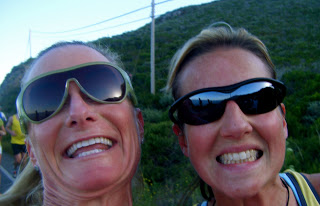
self-pic. with Kelly of Marathon Tours
note to self, self pic’s are never a good idea — especially when taken while running…
36 – Ridge Runner Marathon 06/04/2011 North Bend State Park, WV
Another marathon — state # 25, marathon # 37 — unfolded a few weeks ago in Cairo, WV. Pronounced CARE-o by the locals, Cairo is five+ hours north and west from Washington, DC and deep, deep in the Appalachian Mountains. This tiny marathon — 45 runners strong — began and ended under the deep green and lush canopy of deciduous and evergreen trees of North Bend State Park. The marathon’s middle miles ran through humble towns, enduring along steep and winding lanes, with one-room, time-honored churches dotting the hillsides. Before heading back into the park, we covered 5 miles along a Rail Trail — former railroad line — which took us through extended train tunnels; damp and dank, and dripping in moisture, it was dark and a challenge to see, but provided a welcomed respite from the sun. Gorgeous, and literally breathtaking… check out the marathon’s elevation chart!
Originally part of the great state of Virginia — being a native Virginian, I’m biased — West Virginia broke away to form its own state in 1863. Admittedly taking great liberties here by condensing decades of serious issues and history, West Virginia voted to secede from Virginia in 1863 over social/slavery and economic/geographic issues. One key moment was abolitionist John Brown’s stab to start a slave revolt by seizing a United States Arsenal at Harpers Ferry in 1859. Col. Robert E. Lee defeated Brown’s attempt.
*Factoids: West Virginia was the only state in the Union to secede from a Confederate state during the Civil War. The only other state to be formed during the Civil War was Nevada, which separated from Utah Territory.
*Other Factoids: Famous West Virginians include Author Pearl S. Buck, Confederate general Stonewall Jackson, Actor Don Knotts and Olympic gymnast Mary Lou Retton.
*And Another: Mother’s Day was first observed on May 10, 1908 at Andrews Church in Grafton, WV.
With a mail-in registration form, this stop-watch timed race gets a ‘thumbs up’ for its congenial and relaxed atmosphere. Just 44 other runners and I — about half of which started at the optional 6 AM start — lined up behind the fluorescent-orange spray painted starting line. The woman in blue — front and right (from Annapolis) — was the first woman to cross the line in 3:34. I came in second, about 10 minutes behind.
The Good
The Marathon. Quiet, peaceful, serene, tranquil, still, restful, relaxing, undisturbed. Perfect.
North Bend w Ken and Kath, John about to get dinner at an all-you-can-eat pizza buffet, John (NY), Kath and Ken (FL) and me.
No Bad (sorry)
No Ugly (sorry)
37 – Missoula Marathon 07/10/2011 Missoula, MT
Another marathon has unfolded, this time in Missoula, MT. Wow, what a place! With space still around it, and the Clark Fork River running through it, this college town had a funky spirit mixed with a live-and-let-live attitude. It’s a place that passionately embraces both the outdoors — white water rafting, horseback riding, fishing, hiking, and biking in the summer and skiing and snowmobiling in the winter — and the arts — with theatres, galleries, bookstores and good eating.
Nestled in the heart of the northern Rockies, and in the far western stretches of Montana — just 8 miles from Idaho — Missoula is known as the “Garden City” for its dense green landscape. Missoula lies 140 miles form Glacier National Park and 270 miles from Yellowstone National Park. When we were there, many of the surrounding peaks were still snow-capped.
As recently as 15,000 years ago, the area around Missoula, and much of the areas reaching west into Idaho, were part of Glacial Lake Missoula, formed by the ice-dammed Clark Fork River — same river as in photo below. Then, a series of dramatic geologic events occurred as the melting glacier dam failed, hurtling 200 to 500 cubic miles of escaping water. This water created a river that contained 10 times the water of all the current rivers in the world and drained the lake in just 28 hours. The torrent rocketed downstream with the force that tore through 1,600 square miles, carving magnificent geologic formations in its wake. During the last ice age, this happened at least 100 times!
*Factoid #1: Missoula began as a settlement called Hell Gate but was renamed Missoula, Salish Indian for “near the cold, chilling waters.”
*Factoid #2: Events in the famous book and the 1992 film A River Runs Through It — the real McCoy story about two boys growing up fly fishing in rural Montana — took place just miles from downtown Missoula. Parts of the movie where filmed there, too.
*Factoid #3: Record snow falls and late melt left the rivers high and treacherously fast late into the season.
*Factoid #4: Lewis & Clark made their expedition journey though the Missoula Valley in 1805 and 1806.
The Good
The Marathon. A point to point, starting in Frenchtown and ending in downtown Missoula, this race was voted the best overall marathon by Runner’s World in 2010 With a cool 50 degree start, we ran along country roads, back lanes, through valleys and across rivers, giving us pristine mountains views the whole way. The air was clean with a freshness that’s hard to describe, untainted, punctuated with of pine and flower. I ran alone most of the way, connecting with my surroundings and breath, surprised when 26.2 miles were done, and sprinting to the finish. Plus, it was nice knowing that Favorite Daughter #3 waiting for me at the finish line!
The Horseback Riding. Just minutes from Missoula in Lolo, MT, Favorite Daughter #3 and I saddled up and went to the trails. We wound up and along mountainsides, with better-than-before vistas at every turn. At one point, we cantered through a vast daisy-dotted field. I couldn’t decide if I was exhilarated or scared out of my mind. Probably a little bit of both.
The White Water Rafting. Nearby again, we braved the cold water for a day-long adventure on the Blackfoot River. Thrilling! We took the section from Russell Gates to River Bend and got super-wet along the way. Lesson learned, wetsuits don’t keep you dry with this sort of intense rafting: 3+ class rapids with a CFS (cubic feet per second) of 6,600. During the smooth stretches we searched the skies for bald eagles and ospreys and listened to songbirds.
*Factoid: “Eventually, all things into one, and a river runs through it.” Norman Maclean A River Runs Through It and Other Stories
The Bad
No race-day inhaler. You all know I have asthma and exercise-induced asthma. I take this very seriously as when I don’t follow the protocol, I am unable to
run well. Without going into too much detail, I have two types of inhalers: one that I use every day and one that I use before, and sometimes during, my hard efforts. The latter is what I didn’t have. Well I had it, but the type I use currently, doesn’t have a counter on the top. And it was empty. I was still able to run (obviously), but I felt that my body was ready to push for more, but my lungs couldn’t deliver. Lesson learned and I’ll be ready for the next time it’s a good running day.
The Ugly (sorry, no ugly)
38 – Eagle Creek Trail Marathon 08/06/2011 Indianapolis, IN
Over August 5th and 6th, I made the short trip to Indianapolis, Indiana to run the Eagle Creek Trail Marathon — run on trails, not roads — (state #27 and marathon #38). Hot, hard and humid, this marathon tested me. Was I going to beat the trail, or was the trail going to beat me?
*Personal Factoid: My only other trip to Indy was when I was in 6th grade (see photo above) to watch the Indianapolis 500. It was my first flight too. I remember being terrified of the flight attendant and nervous to ask for a non-alcoholic (in case you thought otherwise!) drink.
*Indiana Factoid #1: Between 1900 and 1920, more than 200 different makes of cars were manufactured in Indiana.
*Indiana factoid #2: Famous Hoosiers include: Abraham Lincoln (born in Kentucky, moved to Indiana as a child – 16th President), Dan Quayle (Senator and 44th US VP), James Dean (actor), “Gus” Grissom (astronaut), Jane Pauley (broadcast journalist), Larry Bird (basketball player), John Mellencamp (singer), Florence Henderson (actor), Johnny Appleseed (John Chapman/Folk Hero), Michael Jackson (singer) and David Letterman (late-night talk show host).
*Indiana factoid #3: The first professional baseball league game was played in Ft. Wayne (1871) and the first US long-distance auto race (recently featured in the Smithsonian Magazine) was held at Indianapolis Motor Speedway (1911).
*Indiana factoid #4: Theories abound as to why Indiana is nicknamed the Hoosier State. But, alas, it remains unclear. Indiana is also known as the “Crossroads of America” for its junction of interstate highways that serve as a trucking base for many trucking lines.
The Good
The Marathon. For all my complaining and boohoo-ing (see The Bad), I was the 10th finisher and the 2nd female to cross the line. Runners followed orange tape tied from trees and bushes, and ran on tight single-track, old road and coarse gravel. The first go-through (this was an out-and-back, run twice), the course was hard to follow, as the tall grass in some areas hadn’t been trampled, and the territory was unfamiliar. Multiple times, I slowed to make sure I was still on track, and twice either I or another close-by runner shouted out to someone who had taken a wrong turn.
The Bad
The Marathon. I want to say that I loved every moment of it, or even some of it, but I can’t. It was hot and humid; yeah, I know it is August… (shorts were dripping wet by mile 8 and socks were soaked through by mile 15). But it was more than that; it was the races punishingly-ongoing mental component (constant appraising of terrain and judging/adjusting — no zoning out or checking the scenery) and surprisingly constant physical demand (endlessly changing course, dodging roots and rocks, and jumping over or climbing under logs/fallen trees). Not that I’m looking for easy, but an occasional break from the excitement would have been nice! I ran the second half of the marathon a full 11 minutes slower (ouch) than the first and felt pretty amateurish. Definitely have a renewed appreciation for trail runners who deftly sail over terrain such as this. *For those new to my updates, I ran the JFK50 (50 mile ultra-marathon) in November of 2009; the first 18 miles of that race was along the Appalachian Trail. I’d forgotten how difficult that was!
The Marathon. It started 26 minutes late. I wouldn’t have cared that much except I had a plane to catch and literally no time to spare.
The Ugly (sorry, no ugly)
39 – Pocatello Marathon 09/03/2011 Pocatello, ID
As we slid through the clear skies from Dulles, through Salt Lake City, UT, to Pocatello, ID, I am thunderstruck (again) by our great country; from its sheer size to its sweeping contrasts in topography, ideology and ethnicity. (I love this country!) Yup, another marathon done (Pocatello Marathon, state #28, marathon #39).
Southern Idaho unfurls abruptly from the Wasatch Range (east) and the Oquirrh Mountains (west); we fly straight through the valley in our tiny propeller plane north to Pocatello (plane switch in SLC). All of a sudden, the land flattens and widens, and we quickly descend into the fifth largest city in Idaho.
Before Europeans arrive in the early 19th century and set up fur trading posts, this area was populated by the Shoshoni and Bannock peoples. Trade between the Europeans and the Native Americans ensues and expands exponentially when Hudson’s Bay Company establish set trading locations to buy/barter manufactured goods (knives, kettles, beads, needles, and blankets).
Around 1860, gold is discovered in Pocatello and its’ surrounds. The first large immigration wave begins and the railroad comes up from Utah. Residential/commercial development starts. Once the gold rush subsides, the region gives way to ranchers and farmers. Hello potatoes (and lentils, sugarbeets, alfalfa hay, dry edible peas and beans, hops, plums/apples and wheat)!
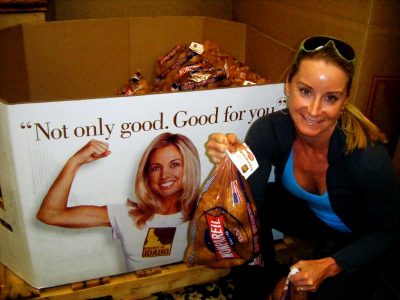
Posing with Alexandria friend & fitness expert, Denise Austin.
Runners receive a sack of potatoes as part of our swag.
*Factoid #1: Meriwether Lewis and William Clark traveled over the Lolo Pass to enter Idaho in September 1805.
*Factoid #2: Famous Idahoans include Sacagawea (Native American guide), Picabo Street (Olympic skier) and Lana Turner (Actor).
And now, without further ado:
Running the Gap Idaho State Journal Pocatello Marathon (its name as long as the marathon…)
Race morning starts out crisp and cloudless. Amazingly dark (given the zillion stars close enough to touch) and silent. Even with 500+ runners, it is quiet, as if everyone agrees not to disrupt the magic of the morning. Wind rustles tall grasses along the roadside, goats bleat off in the distance. I meet up with past running friends. The 50 State-ers (group whose membership has, or is on their way to, completed/ing a marathon in every state) are there, as are the Marathon Maniacs (group whose goal is to run an insane amount of consecutive marathons, making my one-a-month+ seem tame) are omni-present. Not too surprising, I guess, that I’m a member of each club.
We travel by bus from Pocatello out to the start; at 6:15 AM, the gun goes off! We begin our descent down narrow canyon roads. The roads aren’t closed off to traffic, but this poses no problem. Runners from behind congenially alert runners ahead with a “car back” warning. This adds to the friendly spirit of the race as the call travels up the line. Dawn breaks and the sun crests over the tall hills we are now running between . A creek runs along the side. The roads have such great names: Antelope, Buckskin and Hoot Owl. Horses and farms are everywhere; rectangular hay bales pile 7 to 10 high.
The wheelchair and hand cycle participants start first, and will finish (so I overhear) in about an hour and a half.
The Good
The Marathon. With gorgeous scenery and a 1,500′ elevation drop between miles 1 and 14, it is easy to feel pretty darn good. Running by perceived effort (the first 10 miles relaxed and getting into a good rhythm – 70% effort -, the next 10 miles feeling good and in the groove – 75% effort, the last 6 miles keeping it together and counting down the miles – 80% to 100% effort), the miles fly by. I stop to take a few pictures. I chat with fellow runners. I end up running my fastest marathon since St. Jude’s marathon in Memphis, TN – 12/09.
The Bad
The Marathon. Once the course flattens into gentle rollers at about mile 14, I can’t breathe. With the elevation still topping 4,600′, I feel like a goldfish floating sideways in a bowl of murky water. Unable to get enough air to sustain my pace, I start to fail, and fast. Accepting that the altitude has gotten me, I slow down, and even stop and walk for about 8 steps. I shake it off, admonish myself to get it together, and push on.
The Ugly
The Return Trip. Leaving Pocatello on time, and Salt Lake City early, I am fired up to land back at Dulles at a decent hour (11PM). Didn’t happen. There is not one, but two medical emergencies. One forces us to land unexpectedly in Chicago and the other to wait to deplane in Dulles (1:30 AM). Both descents are rapid, where we bank hard and land quickly. The first was emergency is serious. A 33 year old woman in first class has a heart attack and isn’t breathing until a fellow passenger preforms CPR. They yank her from her seat and onto the floor, prop her socked feet up, and pump her chest for what seemed like forever. She leaves the plane breathing on her own; I hope she’s OK. The second emergency isn’t as medically serious. It is stress related due to a less-than-lighthearted mother/ teenage daughter conflict. During the flight, there is lots of back and forth name calling between them.
40 – New Hampshire Marathon 10/01/2011 Bristol, NH
New Hampshire has an extraordinary state motto: “Live free or die: Death is not the worst of evils”. Written as a toast by General John Stark, New Hampshire’s most famous Revolutionary War hero, this assertive declaration reveals our country’s independent character! In fact, New Hampshire was the earliest colony to declare its independence from England (by a full six months), and because of this, was given the honor to cast our new nation’s first vote for freedom.
Formed in 1788 (9th state), and named after Hampshire, England, this New England state is stunning. I was prepared for the leaves (though those weren’t at peak yet), but not for the many lakes and the rushing rivers that fed them.
Random Factoids (in random order) about New Hampshire:
*Factoid #1: The first free public library in the US was opened in Peterborough in 1833.
*Factoid #2: In 1963, NH was the first state to have a legal lottery.
*Factoid #3: Levi Hutchinson of Concord invented the first alarm clock in 1787.
*Factoid #4: Franklin Pierce, a hero in the Mexican-American war, is the only NH resident to be elected president (14th).
*Factoid #5: NH poet and author Sarah Hale wrote “Mary had a Little Lamb” in 1830.
Bristol, NH (the marathon town-host) is an two-stoplight town on Newfound Lake in central New Hampshire. While there, I appreciate its old-style architecture and friendly atmosphere.
I meet up with my friend Jerry who ran his 118th marathon that day. We trade stories about our latest adventures and wish each other well. Jerry went on to run a marathon the next day in Maine. Go Jerry!
We ran all the way around this lake, with a 2+ mile segment out to Sculptured Rocks and back.
The temperature is in the mid-50’s and comfortable race morning. About 250 marathoners (and some 10K runners) mingle and listen to the Bristol Middle School band (the half-marathoners are bused to a separate starting point). Just as the National Anthem is sung, the rain starts. And when the gun goes off, as if on cue, the rain gets heavier and continues all morning, alternating between a light mist and a sideways downpour.
The race begins (and ends) in town at the Middle School. Quickly though, we are to the lake and running along side it. It takes a while to register that the first 6 miles were uphill. Yikes! But the rest of the course mellows out into one big, nice-and-steady roller. The great scenery pushes a lot of the rain-soaked dreariness away. With that being said, I have only an OK run. I hope to find my running-mojo somewhere along the way, but I never do. Sometimes, that just happens…
The Good
The Marathon. Another one done in another great state + I end up placing 3rd Master (over 40).
The Ugly
The Marathon. A cheater! I’ve seen the marathon “cheater-chatter” before on Facebook and seen the cheaters “outed” there, but I’d never seen a cheater cheat in person. Now I have. At about mile 9, someone goes zooming by me, and she is dry. As in NOT WET. I’m soaked by this point; my shoes squish with every step and water drips from my braids. There is no way she could have started with us and been dry. I never learn what (if anything) happens to her, but I’m curious. I hope she feels guilty. *Jerry noticed cheaters in Bristol too and noted that the two he saw were disqualified.
41 – Savannah Rock ‘n’ Roll Marathon 11/05/2011 Savannah, GA
Savannah, Georgia’s first city, is one of the most charming, mysterious and intriguing American cities. Steeped in history and trees laden with Spanish Moss (not of Spanish origin, btw), it had an ethereal “je ne sais quoi”. Click HERE for a great video from Visit Savannah.
Savannah, located in the last of the 13 original colonies, was founded by General James Edward Oglethorpe in 1733. Oglethorpe shaped Savannah and made it the first “planned” city in the US. 14 of the original 16 shady squares remain with Forsythe Park as the centerpiece. Many of the state’s oldest (and most lavish) historic structures are in Savannah.
Savannah and the Savannah Cotton Exchange ruled cotton and set the world cotton prices. But Savannah’s luck changed with the onslaught of the Civil War, a period punctuated by blockades. In his March to the Sea, General Sherman penned this note to President Lincoln on December 21, 1864:
*To His Excellency, President Lincoln:
I beg to present you as a Christmas gift, the city of Savannah, with one hundred and fifty heavy guns and plenty of ammunition, and also about twenty-five thousand bales of cotton.
(Signed.) W. T. Sherman, Major-General
Savannah Factoids in no particular order.
*Factoid #1: Dozens of movies have been fimed in whole or in part in Savannah, including “Cape Fear,” “Forrest Gump,” and “Midnight in the Garden of Good and Evil.”
*Factoid #2: Savannah’s annual St. Patrick’s Day celebration is one of the largest in the nation.
*Factoid #3: Gastronomic Entrepreneur and Famous Chef of southern cooking Paula Deen is from Savannah. We went to her restaurant Lady and Sons to see if we’d spot her and grab dinner, but alas, no luck. So we ate at her sons’ restaurant (Bubba’s) a few miles away. Our hostess is Paula’s long-time friend and says that Paula is just like she is on TV.
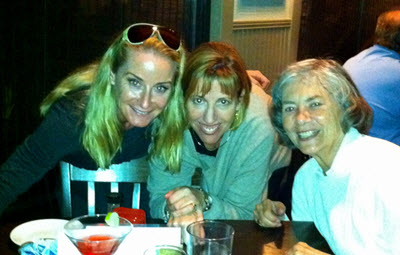
Bubba’s Restaurant
with Joyce (Alexandria friend) and Laura (our hostess with the most-est, local historian and personal tour guide)
*Factoid #4: John Kennedy Jr. and Carolyn Bessette came through Savannah on their way to their secret wedding celebration on Cumberland Island, GA.
*Factoid #5: SCAD (Savannah College of Art and Design) is a relatively new entity in Savannah, but it sure has made a presence. Established in 1978, the college has been instrumental in the purchase and restoration of innumerable buildings, revitalizing large parts of the city.
*Factoid #6: In 1912, Juliette Gordon Low founded The Girl Scouts from her home in Savannah.
And now, without further ado:
The Good
The trip overall. This was a fun weekend full of beautiful weather, friendship and good food. We stayed in the guesthouse of an Alexandria friends’ mother and received first-rate Southern hospitality with our own personal tour guide and historian. Thanks Laura!
The Marathon. I felt great, had a respectable time with a negative-split (ran the 2nd half faster than the 1st half). With 23,000+ runners — this was the first year that the Rock ‘n Roll series managed the event. Generally well-run but with 2 major hiccups (see Ugly), there were energetic and eclectic bands positioned every mile that alleviated a somewhat monotonous course (see Bad). An especially poignant moment occurred early in the race as I was pulling ahead of another runner. Screen printed on the back of his shirt was an adorable boy (about 7 years old) in his baseball uniform. I asked him who the boy was. He replied that it was his son who passed away from cancer a number of years ago. And I proceed to burst into tears… Guess what? He comforts me — and not vice versa — joking that I couldn’t cry because he didn’t want to be responsible for dehydrating me. What an amazing spirit.
The Bad
The Marathon. As stated earlier, Savannah has some truly inspiring streets and scenery, and we ran through almost none of it.
The Ugly that turned into The Good
The Marathon. There were two major traffic-coordination hiccups that need to be addressed ASAP. To be understanding, I know that it was due to this beings Rock ‘n Roll’s inaugural year as the event organizer. But… an hour-long traffic jam to get to packet-pickup is not acceptable. Second, it is not acceptable to get runners to the race start late if they arrived at the shuttle bus area in plenty of time. Joyce dropped me off at 6:05 AM (the final buses scheduled to depart at 7AM) for the 20 minute trip into Savannah. After waiting in a long snaking-line — one of 5, with hundred and hundreds behind me, I boarded at 7:10 AM, arriving at the race at 7:45 (race started at 7:30). By the time I went through bag-drop (and made my way to the start-line) it was 7:50 and I was 11 corrals behind where I should have been…
The Ugly did turn into The Good; the smart marathon-mantra that’s so hard to follow (Start Slow, Finish Fast), is absolutely true. I ran with ease, had a negative split, with a nice kick in the final 5K.
42 – Rehoboth Seashore Marathon 12/10/2011 Rehoboth, DE
Delaware is the second smallest state in the Union — only Rhode Island is smaller — and is the lowest lying state — it is flat! — with the average elevation of only 60 feet. Located in the eastern section of the Delmarva Peninsula, between the Delaware Bay and Chesapeake Bay, Delaware is a straight shot from the DC beltway (home base). No planes, no layovers, and took the regular-sized toothpaste — small pleasures make me happy. Once over the Bay Bridge, we passed through miles and miles of farmland and then mostly closed-for-the-season fruit and vegetable stands. Delaware grows a variety of fruits and vegetables and is a U.S. pioneer in the food-canning industry. Corn, soybeans, potatoes, and hay are significant crops, and Delaware’s broiler-chicken farms satisfy the consumer chicken demand for big Eastern markets. Fishing and dairy play an important role too.
Random DE factoids in random order:
*Factoid #1: English ship captain Samuel Angall named the river and bay separating Delaware and New Jersey after the governor of the English Colony, Lord De La Warr. Delaware takes it name from that river and bay and became our first state in 1787.
*Factoid #2: The state bird is the blue hen chicken and the official state bug is ladybug.
*Factoid #3: Since 1950, the spotlight at the annual Delmarva Chicken Festival has been a 10′ (in diameter) frying pan that holds 180 gallons of oil and fries 800 chicken quarters at a time.
*Factoid #4: DuPont — maker of chemicals and pharmaceuticals — is Delaware’s second largest employer (second only the Delaware state government).
The Good
Rehoboth Beach and the Marathon. Though very quiet in December, it was easy to imagine sunburned families eating ice cream while strolling on the wooden boardwalk. The main avenue is built and ready for the summer vacationers. But in December, it’s cold — about 35 or 40 degrees — and perfect marathon weather! There were more runners than I had expected as we gathered around the bandstand for the 7 AM race start. I looked for people whom I knew were there too — friends from Pacers Running Stores in Alexandria, Paula from ME, Dave and his wife from MA, Jane from Alexandria, VA, and Frank from Arlington, VA. Ken and Kath from FL rode with me after flying into Reagan National. I didn’t see anyone, then heard “Brooke!” It was Frank — we are friends on Facebook but have never met. Frank is an athlete of heroic proportions whose workouts often include running with logs and/or tractor tires on his back. Wow. It was 26.2 miles of laughter hearing his crazy stories. In addition to the camaraderie, it was a beautiful day for a run. The course is scenic — through quiet towns, along sandy wind-swept roads and through silent parkland. At about mile 20, I connected with two of the Pacers’ Running Store ladies — one of whom was trying to qualify for the Boston Marathon and needed to run a sub 3:40. I was supposed to run with her the whole way, but we didn’t connect at the start… I was lucky to find her and run the last five miles together. Way to qualify Heather!
The Bad (that turned good)
The Speeding Ticket. I’ve been a little unlucky in this department recently but that day, the gods were smiling, and I got off with a warning!
The Ugly (no ugly, sorry…)
43 – Icebreaker Indoor Marathon 01/22/2012 Milwaukee, WI
Learning and personal discovery are the two great and unexpected side-rewards of all this marathon-ing for Alexandria’s at-risk. Seeing the country/world, meeting interesting/ideologically-different people and discovering some pretty cool things along the way. Situated on Lake Michigan, Milwaukee was a great surprise. I hadn’t anticipated how much I’d like it. According to the Guinness Book of World Records, Milwaukee hosts the world’s largest outdoor music festival and the city has an overall great vibe — hip downtown and friendly people. When I was there, there was 6 inches of fresh snow and lots to do. The Arts Center, The Harley Davidson Plant and The Miller Brewery Tour were just some of the must-sees.
Random Factoids in Random Order
*Factoid #1: Wisconsin’s first inhabitants (last ice age) were hunters who followed herds of giant bison, elk and wholly mammoths into the region.
*Factoid #2: The French were the first European settlers; they ceded the territory to Britain at the end of the French and Indian War. The US gained control after defeating the British in the American Revolution.
*Factoid #3: Famous Wisconsinites include Laura Ingalis Wilder (Author), Frank Lloyd Wright (Architect), Eric Heiden (Olympic Speed Skater) and the Ringling Brothers (Circus Owners).
*Factoid #4: From 1976 to 1980, the situation-commedy Laverne and Shirley was filmed (at fictional Shotz Brewery) in Milwaukee.
And now, without further ado:
The Good
The Marathon. I admit that I was dreading this one. I envisioned tedious and unrelenting (96) laps — OK, there was some of that — around a monotonous and unending indoor track. But it wasn’t so bad, in fact, it was quite good. The race, held at the Pettit National Ice Center — Olympic training ground for speed skaters, was entertaining and efficient! Kudos to Race Director Chris Ponteri for providing an excellent soundtrack — he had asked for our music-requests, energetic aid-station volunteers who heartily cheered and provided drink/nutrition at every lap, and an overall personal/hometown atmosphere for us (130) runners. There was the Zamboni to watch, the speed skaters to admire and fellow runners to talk. Chris, thanks again for letting me in to your already sold-out race!
*Watch this short video of the Icebreaker Marathon 2012 by Emily Boggs to see exactly what it was like.
The Miller Brewery Tour. A city unto itself, the Miller brewery felt just like what I’d anticipate the set of Willy Wonka and the Chocolate Factory (the 1971 version) to be — ominous yet impressive. Smokestacks and windowless brick buildings flanked either side of the main street. Brewing beer for over 155 years, the plant now uses an unbelievable 500 tons of hops annually, producing 2.2 million cases of beer weekly and 19,200 kegs daily. I took the walking tour of Miller Valley — it’s really called that — and saw the high-speed production lines and tasted the brew at the end.
The Bad
The Asthma. Unfortunately at the beginning of the race, I struggled a bit with my breathing, which at first slowed my pace. I recognized my symptoms, cut back on the effort and used my inhaler. It’s likely that the dry and cold indoor air caused my asthma/EIB (exercise-induced broncospasms) to flare, but honestly, I don’t always know the trigger. But, my strategy worked and I was back on track — sorry, goofy pun intended — to a strong finish!
The Ugly
Sorry, no ugly.
44 – Austin Marathon 02/19/2012 Austin, TX
Located in central Texas just NW of Houston and on the Colorado River, Austin is the state’s capital. The city’s official slogan is “The Live Music Capital of the World” for its many musicians and live music venues — most per capita in the US — but the city’s unofficial slogan is “Keep Austin Weird” for its traditional and proudly eclectic lifestyle of its residents. Austin is an enclave of liberal politics in a generally conservative state and is sometimes sarcastically known as the “People’s Republic of Austin.”

The capitol building is made from Texas pink granite and it served as the capital of the Republic of Texas in 1840-1842. The dome stands seven feet higher than that of our nation’s Capitol
Random Factoids in Random Order
*Factoid #1: Austin is home to North America’s largest urban bat population.
*Factoid #2: The University of Texas is in Austin and has the fifth-largest single-campus enrollment — over 50,000 — in the U.S. Famous UT alumni include: former First Lady Laura Bush and her daughter Jenna Bush, Farrah Fawcett, Walter Cronkite, Matthew McConaughey, Renee Zellweger, and Roger Clemens.
*Factoid #3: In May of 2008, Lance Armstrong opened a bike shop called Mellow Johnny’s. Didn’t spot him but chatted it up with the mayor of running, Bart Yasso (Runner’s World).
The Good
The Marathon. Race day dawned clear — thankfully as it had been raining most of Friday afternoon and all-day Saturday — and I watched from my hotel window runners walk to the Start Line, showing me exactly which way to go. From the 14th floor, they formed an ant-like line following a trail of dropped crumbs. I was happy not have to worry about where to go — my friend whom I was supposed to run with that day got sick overnight, so I had to make it alone. I feel badly for him and a little discombobulated, as I sometimes rely on him and his wife a little too heavily to get me to the start line on time. Austin will be yours next year Ken!
I left my room about 6:45 for a 7 AM start, walked and found my place in the corral just in time for the National Anthem. I’m moved to tears by the beauty of the singers’ voice and song — the sun rises behind the capitol. It’s one of those days you feel lucky to be alive and be able to run. I remove the plastic bag I’m wearing for warmth and take a few puffs of my inhaler. The gun goes off! As usual, the first mile or two are a little rough. And then I start feeling pretty good, and soon I catch up to the 3:35 pace group. I decide to stay with them as long as it feels right — which I do to about mile 21, talking mainly to a 25 year-old-ish woman hoping to qualify for Boston. I’m feeling so good however that I decide to leave the group and push forward in the last few miles to see what I could do. A 3:32:44! It all came together for me and I had a fantastic race. I hit my running zone early and hard, and posted my fastest marathon since December 2009! Austin seemed to be a universe full of creative and athletic energy; I was able to tap right into it, placing 3rd in my Age Group. Best part beyond that? Having helped someone qualify for Boston and sharing a sweaty congratulatory hug at the Finish Line.
The Bad and The Ugly
The weather and the sick friend. Both things were a downer.
45 – Antarctica Marathon 03/09/2012 Antarctica
The adventure begins Thursday, March 1, 2012…
Read the entire story and watch the video here.
46 – Go! St. Louis Marathon 04/18/2012 St. Louis, MO
Go! St. Louis marathon was one of the best organized races in recent memory, with an interesting course, but was a horrible run for me. In fact, it was one of the worst runs ever, full of persistent side-cramps and general malaise.
And now, without further ado, St. Louis, MO…
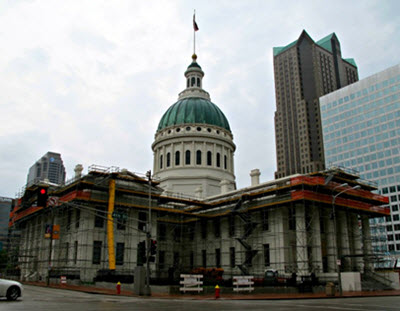
Old Courthouse where the Dred Scott trials (slave husband and wife suing for their freedom in both Missouri State trails and in a Missouri Supreme Court hearing) were held from 1846-1857.
Very brief State History account: The name Missouri originated from a Native American word meaning “place of big canoes.” This refers to large dugout logs that Indians used to travel along the Mississippi and Missouri rivers. France and Spain were the first Europeans to settle the Missouri area — part of the Louisiana Territory — and in 1803, this territory was sold by France to the US as part of the Louisiana Purchase. But before Missouri could become a state — our 24th state (August 10, 1821) — certain compromises had to be made. Designed by statesman Henry Clay, Congress passed the Missouri Compromise in 1820. In order to keep a balance in the Union between the slave and non-slave states,Missouri entered the Union as a slave state, and Maine entered as a free state, thus keeping the ratio of slave and non-slave states the same, at 12 each.
*Factoid #1: Iced tea and the ice cream cone were both invented at the St. Louis World’s Fair of 1904.
*Factoid #2: Famous Missourians include: Sacagawea (Interpreter/guide), Laura Ingalls Wilder and Mark Twain (Authors), Dick Van Dyke and Ginger Rogers (Actors), Harry S. Truman (US President) and George Washington Carver (Scientist/Educator).
*Factoid #3: In 1830, the Mormon leader Joseph Smith declared parts of western Missouri as “Zion,” a gathering place of religious significance.
The Good
St. Louis was hopping! The weekend was packed with people there for an eclectic array of events:
• An estimated 60,000 people were in town for the NRA (National Rifle Association, not National Restaurant Association) convention.
• The St. Louis Blues tied it up 1-1 in Game 2 against the San Jose Sharks at Scottrade Center. The Blues win the series, ending a 10-year drought to make it to the next round.
• At Busch stadium, the Cubs took on the Cardinals. The Cubs won the first two match-ups, the Cardinals went ahead in the third.
The Go! St. Louis Marathon & Family Fitness Weekend was a two-day celebration with over 25,000 participants in 10 separate events. My friends Ken and Kath (from Celebration, FL) joined me, it’s our 7th or 8th marathon run together. Yup, he’s doing the 50 states too. Race-day began with a short walk to the Starting Line. It was 65 degrees at 6 AM and we all wish it were cooler. We corral and the gun goes off! The course took us through downtown streets, by the towering and graceful Arch, and out towards the Anheuser-Busch Brewery. It was hilly and humid, and we felt the temperature rise. It topped 80 degrees later that day, but, thankfully, a lot of the race was run through charming neighborhoods covered by a vast green tree canopy. I hoped that I was going shake out my general malaise, but by mile 5, the side-cramp began, intermittent at first, becoming persistent and severe. During the trek out of the city center and through the beautiful Forest Park and landmark Washington University, the cramp pain increased and debilitated me enough to warrant brief walk-rests to jam my fingers up under my ribcage and massage the area. Unfortunately, I had to continue this protocol for the remainder of the miles. Besides the running (ha ha), it was a great race. There were plenty of water stations, an abundance of enthusiastic crowds — especially the pajama wearing troupe in the Soulard neighborhood — and lots of supportive volunteers.
The Bad and The Ugly
The Marathon. I don’t remember the last time I felt this rotten. The first 5 miles of the marathon were OK, but it went downhill quickly after that. With all the humidity and the throat-coating pollen, I had trouble breathing and I soon developed a significant side-stitch that became increasingly debilitating. Especially during the second half, I had to stop every mile to dig my fingers up under my ribcage to massage it out. Was this cramp a sign of dehydration caused by the heat and humidity — though I thought I was well hydrated before the race and got fluids at every aid station — or was it shallow breathing triggered by the monstrous pollen? Regardless, I crossed the finish line crusted in salt and thrilled to be done.
47 – Fargo Marathon 05/19/2012 Fargo, ND
If you are looking for a great race for easy morning-of logistics, this is it. With plenty of parking, I drove right to the race start listening to the distant thunder rumble and watching the storm cross over the plains. With 25,000 participants, this event could have been a logistical nightmare, but it all went off without a hitch.
There must have been at least two bands at each mile, tons of screaming spectators… and it was pretty cool finishing under Jumbotron video monitors in the FargoDome.
*Factoid #1: Fargo sits on the Red River of the North, one of the few rivers in the world that flows directly north.
*Factoid #2: The average high temperature in January is 14 F, with the average low of -3 F. But the lowest temperature ever recorded in Fargo was -48 F with a windchill of -103 F!
*Factoid #3: The 1996 movie Fargo was filmed mostly in Minnesota.
The Good
Felt good and finished strong.
Listen to my radio interview with KVLY-Fargo
The Bad/Ugly
Sorry, have none for you!
48 – Kona Marathon 06/24/2012 Kona, HI
After visiting the Big Island, you can’t forget a few things: the clean, fresh floral-laden air, the breathtaking and topologically-diverse beauty, and the coffee! We did it all… Running, snorkeling at the Captain Cook memorial in Kealakekua Bay, SUP boarding, helicoptering across the island over active volcanoes and among too-hard-to-describe waterfalls, and relaxing on the Green and Black Sand beaches.
It is believed that Polynesian voyagers from the Marquesas Islands first set foot on the island some 1,500 years ago. Separate chiefdoms developed and war between the factions was common. In 1778, Captain Cook and his two ships were the first Westerners to arrive, and in 1820, missionaries came.
*Factoid #1: The Big Island has 11 different climate zones, each with its own unique ecosystem. There are a total of 13 different climate zones in the world and the only two not represented on The Big Island are the Arctic and Sahara!
*Factoid #2: Mauna Kea is the largest mountain in the state (13,760 feet’). If measured from the ocean floor, it is over 30,000′ making it the largest mountain in the world (4,000′ taller than Mt. Everest).
The Good
This was an all-around awesome trip!
The Bad that turned out Good
There was an error somewhere in the marathon registration process (I had my confirmation email) and I wasn’t registered for the marathon! Thankfully, there was no hassle, and the race director took care of it immediately.
The Ugly
This was a hot, humid, sunny and visually un-stimulating run (once we left Kona) along highways and through immense black lava fields (as far as you could see, that dumped into the ocean). Of interest though is that this is the marathon course for the Kona Ironman, and for them, is run mainly in the dark. Perfect for that purpose!
49 – Deseret News Classic Marathon 07/24/2012 Salt Lake City, UT
First run in 1970, the Deseret News Marathon follows the path of Utah pioneers as they first entered the Salt Lake Valley. The marathon is run on July 24th (Pioneer Day) every year, and this year it was on a Tuesday! It is the oldest road race in Utah and the oldest marathon west of the Continental Divide.
Pioneer Day is a state holiday in Utah and is celebrated much like the 4th of July with parades, barbeques, and fireworks. It commemorates the entry of Brigham Young and the first group of Mormon pioneers into area. The Mormon pioneers viewed their arrival as the founding of a Mormon homeland. Seeking religious freedom in an isolated region, the Mormons left their settlement in Nauvoo, Illinois, and journeyed west. By the end of 1847, nearly 2000 Mormons settled in the Salt Lake Valley.
*Factoid #1: The Mormon Temple took 40 years to complete.
*Factoid #2: The Great Salt Lake covers 2,100 square miles and has an average depth of 13′.
*Factoid #3: Average snowfall in the mountains near Salt Lake City is 500”. The snow is unusually dry, giving this area the reputation of having some of the world’s greatest powder.
The Good: This was a truly spectacular run scenery-wise as we started at Big Mountain (7,200′ elevation!) above Emigration Canyon, and watched the sun finally push up over the mountain top as we snaked our way down to Salt Lake City. This was a total elevation drop of 3,200′, except for a few painful uphill miles between miles 6 and 8.
Lots of great media happened in Salt Lake.
The Bad/The Ugly
Sorry, none to report.
50 – Leading Ladies 08/19/2012 Spearfish, SD
I am still amazed by the breathtaking beauty of the Black Hills and its surrounds (Mt. Rushmore, Crazy Horse memorial, 2 hour caving tour, and Devils Tower – no apostrophe – in Wyoming). We did it all!
*Factoid #1: In 1927, sculptor Gutzon Borglum began drilling into the 6,200-foot Mount Rushmore as a shrine to Democracy. It took 14 years and $1 million.
*Factoid #2: Famous North Dakotans include: Tom Brokow (TV newscaster), Cheryl Ladd (actor) and Hubert Humphrey (vice president)
The Good
This was an all female, all downhill (relatively) race threading the Black Hills canyons. A rushing stream paralleled the course, with towering limestone cliffs on either side. Peaceful and uber-tranquil, I ran well and saw lots of wildlife, flora/fauna and cabins tucked away among the soaring evergreen trees.
The Bad
It was a pain to get there, fraught with travel delays and missed connections.
Back to the full list of marathons
*Brooke pays for all of her own travel costs and related fees. She runs (24,000 miles and counting…) with asthma and exercise-induced asthma.


